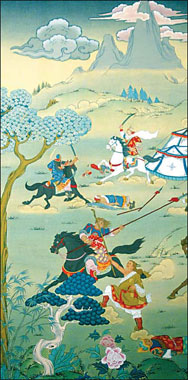
Tibetan Buddhists developed the unique art of Thangka painting, the religious art on scrolls that can be rolled up and packed for travel, in order to take devotional images on the road. Today these beautiful paintings are considered prime examples of the region's celebrated artistic and cultural heritage.
Now a collection of modern Thangka paintings, created by more than 200 living artists and researchers, recounts the story of Tibet's central epic poem, The Epic of King Gesar. The collection is currently on display at the Cultural Palace of Nationalities in Beijing.
Handed down by generations of ballad singers in Sichuan, Yunnan, Tibet, Qinghai, Xinjiang and Inner Mongolia for more than 1,000 years, The Epic of King Gesar is considered one of the world's greatest literary epics. It tells of how the half-human, half-god Tibetan king conquered the devils of other tribes and sought to help ordinary people.
"The Epic is more than folk tales. It is like an oral encyclopedia about Tibetan culture and history," says Genqiu Tashi, an artist who also founded the program that supported the production of the new paintings, the King Gesar Epic Thangka Painting Series.
At the exhibit, visitors will be able to see Tibetan artists demonstrate their painting techniques and watch live performances by artists from the Garze Tibetan Song and Dance Troupe and other musicians sing songs from The Epic of King Gesar.
On display are 270 Thangka paintings. Each painting was the product of intense artistic collaboration. Painters and craftsmen were divided into groups. Each was responsible for one of the eight major painting stages, including the monochrome sketching, initial color rendering, tracing in gold dust, eye-depiction, polishing and mounting.

The Thangka painters adhered to traditional painting techniques, making use of natural or mineral colors, and even gold dust or ground powder of precious stones.
But the artists did not simply repeat the work of past masters. One unique aspect of these modern paintings is that they feature King Gesar as the focal point of the image, unlike traditional works that usually portray the Buddha or other Buddhist gods and goddesses as the centerpiece.
China Daily
Address: Cultural Palace of Nationalities, 49 Fuxingmennei Dajie, Xicheng district 西城区复兴门内大街49号民族文化宫
Open: 9 am-4 pm, until Aug 20
Performances: two musical performances daily, one approximately 9:30 am, the other approximately 2 pm
Tel: 6601-6806